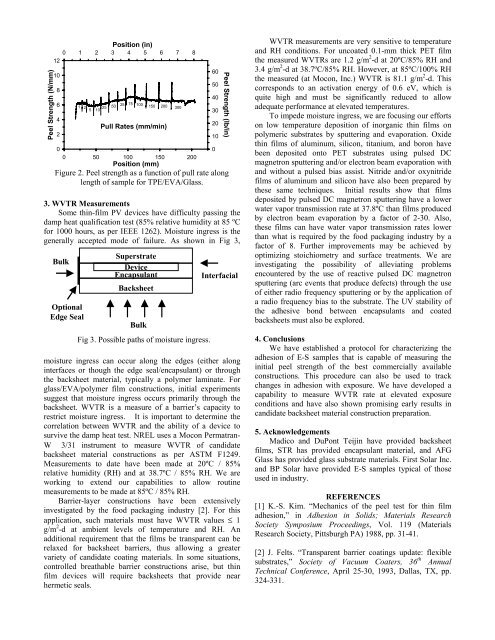Measurements of Backsheet Moisture Permeation and Encapsulant ...
Measurements of Backsheet Moisture Permeation and Encapsulant ...
Measurements of Backsheet Moisture Permeation and Encapsulant ...
You also want an ePaper? Increase the reach of your titles
YUMPU automatically turns print PDFs into web optimized ePapers that Google loves.
Peel Strength (N/mm)<br />
12<br />
10<br />
8<br />
6<br />
4<br />
2<br />
3. WVTR <strong>Measurements</strong><br />
Some thin-film PV devices have difficulty passing the<br />
damp heat qualification test (85% relative humidity at 85 ºC<br />
for 1000 hours, as per IEEE 1262). <strong>Moisture</strong> ingress is the<br />
generally accepted mode <strong>of</strong> failure. As shown in Fig 3,<br />
Bulk<br />
Position (in)<br />
0 1 2 3 4 5 6 7 8<br />
Optional<br />
Edge Seal<br />
1 2 5 10 25<br />
50<br />
25<br />
75 100 150 200 300<br />
Pull Rates (mm/min)<br />
0<br />
0 50 100 150 200<br />
Position (mm)<br />
Figure 2. Peel strength as a function <strong>of</strong> pull rate along<br />
length <strong>of</strong> sample for TPE/EVA/Glass.<br />
Superstrate<br />
Device<br />
<strong>Encapsulant</strong><br />
<strong>Backsheet</strong><br />
Bulk<br />
Fig 3. Possible paths <strong>of</strong> moisture ingress.<br />
Interfacial<br />
moisture ingress can occur along the edges (either along<br />
interfaces or though the edge seal/encapsulant) or through<br />
the backsheet material, typically a polymer laminate. For<br />
glass/EVA/polymer film constructions, initial experiments<br />
suggest that moisture ingress occurs primarily through the<br />
backsheet. WVTR is a measure <strong>of</strong> a barrier’s capacity to<br />
restrict moisture ingress. It is important to determine the<br />
correlation between WVTR <strong>and</strong> the ability <strong>of</strong> a device to<br />
survive the damp heat test. NREL uses a Mocon Permatran-<br />
W 3/31 instrument to measure WVTR <strong>of</strong> c<strong>and</strong>idate<br />
backsheet material constructions as per ASTM F1249.<br />
<strong>Measurements</strong> to date have been made at 20ºC / 85%<br />
relative humidity (RH) <strong>and</strong> at 38.7ºC / 85% RH. We are<br />
working to extend our capabilities to allow routine<br />
measurements to be made at 85ºC / 85% RH.<br />
Barrier-layer constructions have been extensively<br />
investigated by the food packaging industry [2]. For this<br />
application, such materials must have WVTR values ≤ 1<br />
g/m 2 -d at ambient levels <strong>of</strong> temperature <strong>and</strong> RH. An<br />
additional requirement that the films be transparent can be<br />
relaxed for backsheet barriers, thus allowing a greater<br />
variety <strong>of</strong> c<strong>and</strong>idate coating materials. In some situations,<br />
controlled breathable barrier constructions arise, but thin<br />
film devices will require backsheets that provide near<br />
hermetic seals.<br />
60<br />
50<br />
40<br />
30<br />
20<br />
10<br />
0<br />
Peel Strength (lb/in)<br />
WVTR measurements are very sensitive to temperature<br />
<strong>and</strong> RH conditions. For uncoated 0.1-mm thick PET film<br />
the measured WVTRs are 1.2 g/m 2 -d at 20ºC/85% RH <strong>and</strong><br />
3.4 g/m 2 -d at 38.7ºC/85% RH. However, at 85ºC/100% RH<br />
the measured (at Mocon, Inc.) WVTR is 81.1 g/m 2 -d. This<br />
corresponds to an activation energy <strong>of</strong> 0.6 eV, which is<br />
quite high <strong>and</strong> must be significantly reduced to allow<br />
adequate performance at elevated temperatures.<br />
To impede moisture ingress, we are focusing our efforts<br />
on low temperature deposition <strong>of</strong> inorganic thin films on<br />
polymeric substrates by sputtering <strong>and</strong> evaporation. Oxide<br />
thin films <strong>of</strong> aluminum, silicon, titanium, <strong>and</strong> boron have<br />
been deposited onto PET substrates using pulsed DC<br />
magnetron sputtering <strong>and</strong>/or electron beam evaporation with<br />
<strong>and</strong> without a pulsed bias assist. Nitride <strong>and</strong>/or oxynitride<br />
films <strong>of</strong> aluminum <strong>and</strong> silicon have also been prepared by<br />
these same techniques. Initial results show that films<br />
deposited by pulsed DC magnetron sputtering have a lower<br />
water vapor transmission rate at 37.8ºC than films produced<br />
by electron beam evaporation by a factor <strong>of</strong> 2-30. Also,<br />
these films can have water vapor transmission rates lower<br />
than what is required by the food packaging industry by a<br />
factor <strong>of</strong> 8. Further improvements may be achieved by<br />
optimizing stoichiometry <strong>and</strong> surface treatments. We are<br />
investigating the possibility <strong>of</strong> alleviating problems<br />
encountered by the use <strong>of</strong> reactive pulsed DC magnetron<br />
sputtering (arc events that produce defects) through the use<br />
<strong>of</strong> either radio frequency sputtering or by the application <strong>of</strong><br />
a radio frequency bias to the substrate. The UV stability <strong>of</strong><br />
the adhesive bond between encapsulants <strong>and</strong> coated<br />
backsheets must also be explored.<br />
4. Conclusions<br />
We have established a protocol for characterizing the<br />
adhesion <strong>of</strong> E-S samples that is capable <strong>of</strong> measuring the<br />
initial peel strength <strong>of</strong> the best commercially available<br />
constructions. This procedure can also be used to track<br />
changes in adhesion with exposure. We have developed a<br />
capability to measure WVTR rate at elevated exposure<br />
conditions <strong>and</strong> have also shown promising early results in<br />
c<strong>and</strong>idate backsheet material construction preparation.<br />
5. Acknowledgements<br />
Madico <strong>and</strong> DuPont Teijin have provided backsheet<br />
films, STR has provided encapsulant material, <strong>and</strong> AFG<br />
Glass has provided glass substrate materials. First Solar Inc.<br />
<strong>and</strong> BP Solar have provided E-S samples typical <strong>of</strong> those<br />
used in industry.<br />
REFERENCES<br />
[1] K.-S. Kim. “Mechanics <strong>of</strong> the peel test for thin film<br />
adhesion,” in Adhesion in Solids; Materials Research<br />
Society Symposium Proceedings, Vol. 119 (Materials<br />
Research Society, Pittsburgh PA) 1988, pp. 31-41.<br />
[2] J. Felts. “Transparent barrier coatings update: flexible<br />
substrates,” Society <strong>of</strong> Vacuum Coaters, 36 th Annual<br />
Technical Conference, April 25-30, 1993, Dallas, TX, pp.<br />
324-331.
















